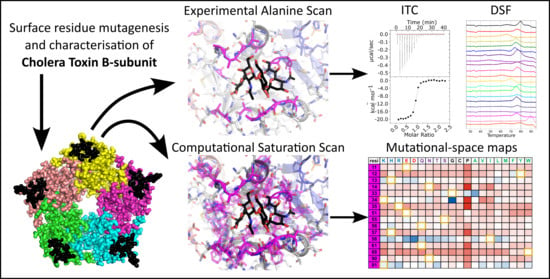The Mutagenic Plasticity of the Cholera Toxin B-Subunit Surface Residues: Stability and Affinity
Abstract
1. Introduction
2. Results
2.1. Computational Saturation Scan—CTB Ligand-Free Structure
2.2. Computational Saturation Scan—CTB Ligand-Bound Structure
2.3. Expression of CTB Alanine Scan Mutants
2.4. Differential Scanning Fluorimetry of Alanine Scan Mutants
2.5. Isothermal Titration Calorimetry of Alanine Scan Mutants
3. Discussion
4. Materials and Methods
4.1. Computational Setup
4.2. Computational Alanine Scan (Stability)
4.3. Computational Saturation Scan (Stability)
4.4. Computational Saturation Scan (Ligand Interaction)
4.5. Molecular Biology
4.6. Gene Expression and Protein Purification
4.7. Sodium Dodecyl-Sulfate Polyacrylamide Gel Electrophoresis
4.8. Differential Scanning Fluorimetry
4.9. Isothermal Titration Calorimetry
Supplementary Materials
Author Contributions
Funding
Data Availability Statement
Acknowledgments
Conflicts of Interest
References
- Pärnaste, L.; Arukuusk, P.; Zagato, E.; Braeckmans, K.; Langel, Ü. Methods to Follow Intracellular Trafficking of Cell-Penetrating Peptides. J. Drug Target. 2016, 24, 508–519. [Google Scholar] [CrossRef]
- Li, Y.; Gao, L.; Tan, X.; Li, F.; Zhao, M.; Peng, S. Lipid Rafts-Mediated Endocytosis and Physiology-Based Cell Membrane Traffic Models of Doxorubicin Liposomes. Biochim. Biophys. Acta Biomembr. 2016, 1858, 1801–1811. [Google Scholar] [CrossRef]
- Riyad, J.M.; Weber, T. Intracellular Trafficking of Adeno-Associated Virus (AAV) Vectors: Challenges and Future Directions. Gene Ther. 2021, 28, 683–696. [Google Scholar] [CrossRef]
- Zheng, G.; Chen, J.; Li, H.; Glickson, J.D. Rerouting Lipoprotein Nanoparticles to Selected Alternate Receptors for the Targeted Delivery of Cancer Diagnostic and Therapeutic Agents. Proc. Natl. Acad. Sci. USA 2005, 102, 17757–17762. [Google Scholar] [CrossRef]
- Johannes, L.; Decaudin, D. Protein Toxins: Intracellular Trafficking for Targeted Therapy. Gene Ther. 2005, 12, 1360–1368. [Google Scholar] [CrossRef] [PubMed]
- Walker, W.A.; Tarannum, M.; Vivero-Escoto, J.L. Cellular Endocytosis and Trafficking of Cholera Toxin B-Modified Mesoporous Silica Nanoparticles. J. Mater. Chem. B 2016, 4, 1254. [Google Scholar] [CrossRef] [PubMed]
- Kenworthy, A.K.; Schmieder, S.S.; Raghunathan, K.; Tiwari, A.; Wang, T.; Kelly, C.V.; Lencer, W.I. Cholera Toxin as a Probe for Membrane Biology. Toxins 2021, 13, 543. [Google Scholar] [CrossRef] [PubMed]
- Lönnroth, I.; Holmgren, J. Subunit Structure of Cholera Toxin. J. Gen. Microbiol. 1973, 76, 417–427. [Google Scholar] [CrossRef] [PubMed]
- Stratmann, T. Cholera Toxin Subunit b as Adjuvant—An Accelerator in Protective Immunity and a Break in Autoimmunity. Vaccines 2015, 3, 579. [Google Scholar] [CrossRef] [PubMed]
- Yao, F.; Zhang, E.; Gao, Z.; Ji, H.; Marmouri, M.; Xia, X. Did You Choose Appropriate Tracer for Retrograde Tracing of Retinal Ganglion Cells. the Differences between Cholera Toxin Subunit B and Fluorogold. PLoS ONE 2018, 13, e0205133. [Google Scholar] [CrossRef]
- Balmforth, M.R.; Haigh, J.; Kumar, V.; Dai, W.; Tiede, C.; Tomlinson, D.C.; Deuchars, J.; Webb, M.E.; Turnbull, W.B. Piggybacking on the Cholera Toxin: Identification of a CTB-Binding Protein as an Approach for Targeted Delivery of Proteins to Motor Neurons. Bioconjug. Chem. 2021, 32, 2205–2212. [Google Scholar] [CrossRef]
- Ae, A.J.S.; Ae, F.O.E.; Benitez, J.A. Exploiting Cholera Vaccines as a Versatile Antigen Delivery Platform. Biotechnol. Lett. 2008, 30, 571–579. [Google Scholar] [CrossRef]
- Ross, J.F.; Wildsmith, G.C.; Johnson, M.; Hurdiss, D.; Hollingsworth, K.; Thompson, R.F.; Mosayebi, M.; Trinh, C.H.; Paci, E.; Pearson, A.R.; et al. Directed Assembly of Homopentameric Cholera Toxin B-Subunit Proteins into Higher-Order Structures Using Coiled-Coil Appendages. J. Am. Chem. Soc. 2019, 141, 5211–5219. [Google Scholar] [CrossRef]
- Wehrum, S.; Siukstaite, L.; Williamson, D.J.; Branson, T.R.; Sych, T.; Madl, J.; Wildsmith, G.C.; Dai, W.; Kempmann, E.; Ross, J.F.; et al. Membrane Fusion Mediated by Non-Covalent Binding of Re-Engineered Cholera Toxin Assemblies to Glycolipids. ACS Synth. Biol. 2022, 11, 3929–3938. [Google Scholar] [CrossRef]
- Dolan, J.P.; Machin, D.C.; Dedola, S.; Field, R.A.; Webb, M.E.; Turnbull, W.B. Synthesis of Cholera Toxin B Subunit Glycoconjugates Using Site-Specific Orthogonal Oxime and Sortase Ligation Reactions. Front. Chem. 2022, 10, 958272. [Google Scholar] [CrossRef] [PubMed]
- Holmgren, J.; Lonnroth, I.; Manssont, J.-E.; Svennerholmt, L. Interaction of Cholera Toxin and Membrane GM1 Ganglioside of Small Intestine. Proc. Natl. Acad. Sci. USA 1975, 72, 2520–2524. [Google Scholar]
- Cervin, J.; Wands, A.M.; Casselbrant, A.; Wu, H.; Krishnamurthy, S.; Cvjetkovic, A.; Estelius, J.; Dedic, B.; Sethi, A.; Wallom, K.L.; et al. GM1 Ganglioside-Independent Intoxication by Cholera Toxin. PLoS Pathog. 2018, 14, e1006862. [Google Scholar] [CrossRef] [PubMed]
- Singla, A.; Boucher, A.; Wallom, K.-L.; Lebens, M.; Kohler, J.J.; Platt, F.M.; Yrlid, U. Cholera Intoxication of Human Enteroids Reveals Interplay between Decoy and Functional Glycoconjugate Ligands. Glycobiology 2023, 33, 801–816. [Google Scholar] [CrossRef]
- Lencer, W.I.; Saslowsky, D. Raft Trafficking of AB 5 Subunit Bacterial Toxins. Biochim. Biophys. Acta 2005, 1746, 314–321. [Google Scholar] [CrossRef] [PubMed]
- Sandvig, K.; Ryd, M.; Garred, I.; Schweda, E.; Holm, P.K.; Van Deursll, B. Retrograde Transport from the Golgi Complex to the ER of Both Shiga Toxin and the Nontoxic Shiga B-Fragment Is Regulated by Butyric Acid and CAMP. J. Cell Biol. 1994, 126, 53–64. [Google Scholar] [CrossRef]
- Machin, D.C.; Williamson, D.J.; Fisher, P.; Miller, V.J.; Wildsmith, G.C.; Ross, J.F.; Wasson, C.; Macdonald, A.; Andrews, B.I.; Ungar, D.; et al. Sortase-Modified Cholera Toxoids Show Specific Golgi Localization. ChemRxiv 2019, 1–6. [Google Scholar] [CrossRef]
- Lencer, W.L.; Constable, C.; Moe, S.; Jobling, M.G.; Webb, I.H.M.; Ruston, S.; Madara, J.L.; Hirst, T.R.; Holmesll, R.K. Targeting of Cholera Toxin and Escherichia Coli Heat Labile Toxin in Polarized Epithelia: Role of COOH-Terminal KDEL. J. Cell Biol. 1995, 131, 951–962. [Google Scholar] [CrossRef]
- Wernick, N.L.B.; Chinnapen, D.J.F.; Cho, J.A.; Lencer, W.I. Cholera Toxin: An Intracellular Journey into the Cytosol by Way of the Endoplasmic Reticulum. Toxins 2010, 2, 310–325. [Google Scholar] [CrossRef]
- Chinnapen, D.J.F.; Chinnapen, H.; Saslowsky, D.; Lencer, W.I. Rafting with Cholera Toxin: Endocytosis and Trafficking from Plasma Membrane to ER. FEMS Microbiol. Lett. 2007, 266, 129–137. [Google Scholar] [CrossRef]
- Ledeen, R.W.; Wu, G.; Lu, Z.H.; Kozireskichuback, D.; Fang, Y. The Role of GM1 and Other Gangliosides in Neuronal Differentiation: Overview and New Findings. Ann. N. Y. Acad. Sci. 1998, 845, 161–175. [Google Scholar] [CrossRef]
- Gonzalez Porras, M.A.; Durfee, P.; Giambini, S.; Sieck, G.C.; Brinker, C.J.; Mantilla, C.B. Uptake and Intracellular Fate of Cholera Toxin Subunit B-Modified Mesoporous Silica Nanoparticle-Supported Lipid Bilayers (Aka Protocells) in Motoneurons. Nanomedicine 2018, 14, 661–672. [Google Scholar] [CrossRef]
- Weinbaum, S.; Tarbell, J.M.; Damiano, E.R. The Structure and Function of the Endothelial Glycocalyx Layer. Annu. Rev. Biomed. Eng. 2007, 9, 121–167. [Google Scholar] [CrossRef]
- Purcell, S.C.; Godula, K. Synthetic Glycoscapes: Addressing the Structural and Functional Complexity of the Glycocalyx. Interface Focus 2019, 9, 20180080. [Google Scholar] [CrossRef] [PubMed]
- Rodriguez, E.; Schetters, S.T.T.; van Kooyk, Y. The Tumour Glyco-Code as a Novel Immune Checkpoint for Immunotherapy. Nat. Rev. Immunol. 2018, 18, 204–211. [Google Scholar] [CrossRef] [PubMed]
- Majoul, I.; Schmidt, T.; Pomasanova, M.; Boutkevich, E.; Kozlov, Y.; Söling, H.D. Differential Expression of Receptors for Shiga and Cholera Toxin Is Regulated by the Cell Cycle. J. Cell Sci. 2002, 115, 817–826. [Google Scholar] [CrossRef] [PubMed]
- Jin, X.; Yang, G.Y. Pathophysiological Roles and Applications of Glycosphingolipids in the Diagnosis and Treatment of Cancer Diseases. Prog. Lipid Res. 2023, 91, 101241. [Google Scholar] [CrossRef] [PubMed]
- Freitas, R.; Peixoto, A.; Ferreira, E.; Miranda, A.; Santos, L.L.; Ferreira, J.A. Immunomodulatory Glycomedicine: Introducing next Generation Cancer Glycovaccines. Biotechnol. Adv. 2023, 65, 108144. [Google Scholar] [CrossRef]
- Sait, S.; Modak, S. Anti-GD2 Immunotherapy for Neuroblastomas. Expert Rev. Anticancer Ther. 2017, 17, 889–904. [Google Scholar] [CrossRef] [PubMed]
- Watanabe, R.; Ohyama, C.; Aoki, H.; Takahashi, T.; Satoh, M.; Saito, S.; Hoshi, S.; Ishii, A.; Saito, M.; Arai, Y. Ganglioside G M3 Overexpression Induces Apoptosis and Reduces Malignant Potential in Murine Bladder Cancer. Cancer Res. 2002, 62, 3850–3854. [Google Scholar] [PubMed]
- Nazha, B.; Inal, C.; Owonikoko, T.K. Disialoganglioside GD2 Expression in Solid Tumors and Role as a Target for Cancer Therapy. Front. Oncol. 2020, 10, 1000. [Google Scholar] [CrossRef] [PubMed]
- Jobling, M.G.; Homles, R.K. Analysis of Structure and Function of the B Subunit of Cholera Toxin by the Use of Site-Directed Mutagenesis. Mol. Mircobiol. 1991, 5, 1755–1767. [Google Scholar] [CrossRef]
- Jobling, M.G.; Holmes, R.K. Mutational Analysis of Ganglioside GM1-Binding Ability, Pentamer Formation, and Epitopes of Cholera Toxin B (CTB) Subunits and CTB/Heat-Labile Enterotoxin B Subunit Chimeras. Infect. Immun. 2002, 70, 1260–1271. [Google Scholar] [CrossRef]
- Aman, A.T.; Fraser, S.; Merritt, E.A.; Rodigherio, C.; Kenny, M.; Ahn, M.; Hol, W.G.J.; Williams, N.A.; Lencer, W.I.; Hirst, T.R. A Mutant Cholera Toxin B Subunit That Binds GM1- Ganglioside but Lacks Immunomodulatory or Toxic Activity. Proc. Natl. Acad. Sci. USA 2001, 98, 8536–8541. [Google Scholar] [CrossRef]
- Tinker, J.K.; Erbe, J.L.; Hol, W.G.J.; Holmes, R.K. Cholera Holotoxin Assembly Requires a Hydrophobic Domain at the A-B5 Interface: Mutational Analysis and Development of an in Vitro Assembly System. Infect. Immun. 2003, 71, 4093–4101. [Google Scholar] [CrossRef]
- Vasile, F.; Reina, J.J.; Potenza, D.; Heggelund, J.E.; Mackenzie, A.; Krengel, U.; Bernardi, A. Comprehensive Analysis of Blood Group Antigen Binding to Classical and El Tor Cholera Toxin B-Pentamers by NMR. Glycobiology 2014, 24, 766–778. [Google Scholar] [CrossRef]
- Dallas, W.S.; Falkow, F. The Molecular Nature of Heat-Labile (L T) of Escherichia Coli. Nature 1979, 277, 406–407. [Google Scholar] [CrossRef]
- Karasawa, T.; Ito, H.; Tsukamoto, T.; Yamasaki, S.; Kurazono, H.; Faruque, S.M.; Nair, G.B.; Nishibuchi, M.; Takeda, Y. Cloning and Characterization of Genes Encoding Homologues of the B Subunit of Cholera Toxin and the Escherichia Coli Heat-Labile Enterotoxin from Clinical Isolates of Citrobacter Freundii and E. coli. Infect. Immun. 2002, 70, 7153–7155. [Google Scholar] [CrossRef][Green Version]
- Ng, N.M.; Littler, D.R.; Paton, A.W.; Rô Me Le Nours, J.; Rossjohn, J.; Paton, J.C.; Beddoe, T. EcxAB Is a Founding Member of a New Family of Metalloprotease AB 5 Toxins with a Hybrid Cholera-like B Subunit. Structure 2013, 21, 2003–2013. [Google Scholar] [CrossRef]
- Turnbull, W.B.; Precious, B.L.; Homans, S.W. Dissecting the Cholera Toxin-Ganglioside GM1 Interaction by Isothermal Titration Calorimetry. J. Am. Chem. Soc. 2004, 126, 1047–1054. [Google Scholar] [CrossRef]
- Mandal, P.K.; Branson, T.R.; Hayes, E.D.; Ross, J.F.; Gavín, J.A.; Daranas, A.H.; Turnbull, W.B. Towards a Structural Basis for the Relationship between Blood Group and the Severity of El Tor Cholera. Angew. Chem. Int. Ed. 2012, 51, 5143–5146. [Google Scholar] [CrossRef]
- Merritt, E.A.; Sarfaty, S.; Jobling, M.G.; Chang, T.; Holmes, R.K.; Hirst, T.R.; Hol, W.G.J. Structural Studies of Receptor Binding by Cholera Toxin Mutants. Protein Sci. 1997, 6, 1516–1528. [Google Scholar] [CrossRef] [PubMed]
- Alford, R.F.; Leaver-Fay, A.; Jeliazkov, J.R.; O’Meara, M.J.; DiMaio, F.P.; Park, H.; Shapovalov, M.V.; Renfrew, P.D.; Mulligan, V.K.; Kappel, K.; et al. The Rosetta All-Atom Energy Function for Macromolecular Modeling and Design. J. Chem. Theory Comput. 2017, 13, 3031–3048. [Google Scholar] [CrossRef] [PubMed]
- Labonte, J.W.; Adolf-Bryfogle, J.; Schief, W.R.; Gray, J.J. Residue-Centric Modeling and Design of Saccharide and Glycoconjugate Structures. J. Comput. Chem. 2017, 38, 276–287. [Google Scholar] [CrossRef] [PubMed]
- Heggelund, J.E.; Burschowsky, D.; Bjørnestad, V.A.; Hodnik, V.; Anderluh, G.; Krengel, U. High-Resolution Crystal Structures Elucidate the Molecular Basis of Cholera Blood Group Dependence. PLoS Pathog. 2016, 12, e1005567. [Google Scholar] [CrossRef] [PubMed]
- Branson, T.R.; McAllister, T.E.; Garcia-Hartjes, J.; Fascione, M.A.; Ross, J.F.; Warriner, S.L.; Wennekes, T.; Zuilhof, H.; Turnbull, W.B. A Protein-Based Pentavalent Inhibitor of the Cholera Toxin B-Subunit. Angew. Chem. Int. Ed. 2014, 53, 8323–8327. [Google Scholar] [CrossRef] [PubMed]
- Dertzbaugh, M.T.; Cox, L.M. The Affinity of Cholera Toxin for Ni2+ Ion. Protein Eng. 1998, 11, 577–581. [Google Scholar] [CrossRef] [PubMed]
- Niesen, F.H.; Berglund, H.; Vedadi, M. The Use of Differential Scanning Fluorimetry to Detect Ligand Interactions That Promote Protein Stability. Nat. Protoc. 2007, 2, 2212–2221. [Google Scholar] [CrossRef] [PubMed]
- Goins, B.; Freire, E. Thermal Stability and Intersubunit Interactions of Cholera Toxin in Solution and in Association with Its Cell-Surface Receptor Ganglioside GM1. Biochemistry 1988, 27, 2046–2052. [Google Scholar] [CrossRef]
- Chen, W.; Enck, S.; Price, J.L.; Powers, D.L.; Powers, E.T.; Wong, C.H.; Dyson, H.J.; Kelly, J.W. Structural and Energetic Basis of Carbohydrate-Aromatic Packing Interactions in Proteins. J. Am. Chem. Soc. 2013, 135, 9877–9884. [Google Scholar] [CrossRef]
- Hudson, K.L.; Bartlett, G.J.; Diehl, R.C.; Agirre, J.; Gallagher, T.; Kiessling, L.L.; Woolfson, D.N. Carbohydrate-Aromatic Interactions in Proteins. J. Am. Chem. Soc. 2015, 137, 15152–15160. [Google Scholar] [CrossRef]
- Bäckström, M.; Shahabi, V.; Johansson, S.; Teneberg, S.; Kjellberg, A.; Miller-Podraza, H.; Holmgren, J.; Lebens, M. Structural Basis for Differential Receptor Binding of Cholera and Escherichia Coli Heat-Labile Toxins: Influence of Heterologous Amino Acid Substitutions in the Cholera B-Subunit. Mol. Microbiol. 1997, 24, 489–497. [Google Scholar] [CrossRef]
- Merritt, E.A.; Kuhn, P.; Sarfaty, S.; Erbe, J.L.; Holmes, R.K.; Hol, W.G.J. The 1.25 Å Resolution Refinement of the Cholera Toxin B-Pentamer: Evidence of Peptide Backbone Strain at the Receptor-Binding Site. J. Mol. Biol. 1998, 282, 1043–1059. [Google Scholar] [CrossRef] [PubMed]
- Au, C.W.; Ross, J.F. Computational and Experimental Data on Surface Mutations to Cholera Toxin B-Subunit. [Dataset]. 2024. [Google Scholar] [CrossRef]
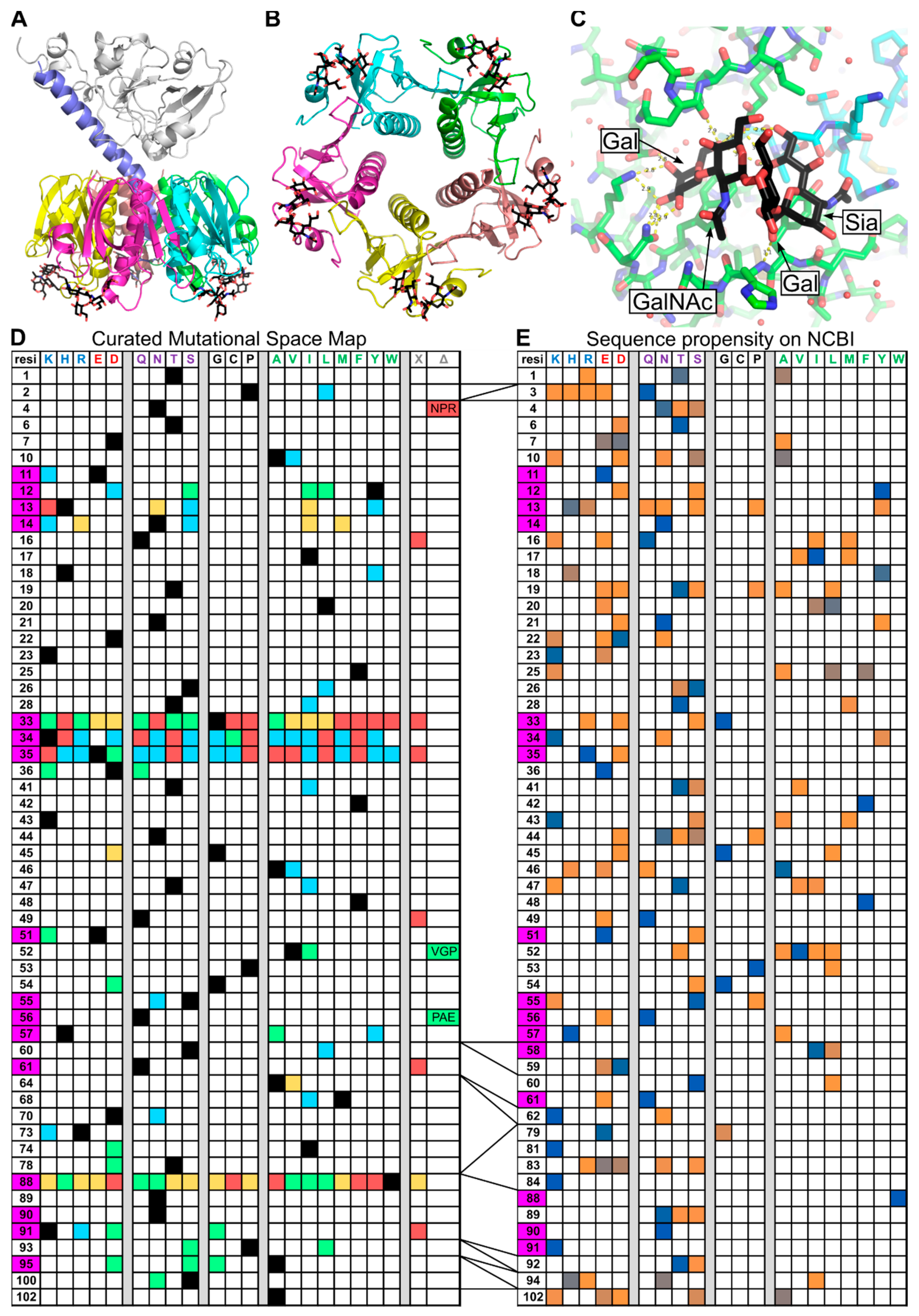

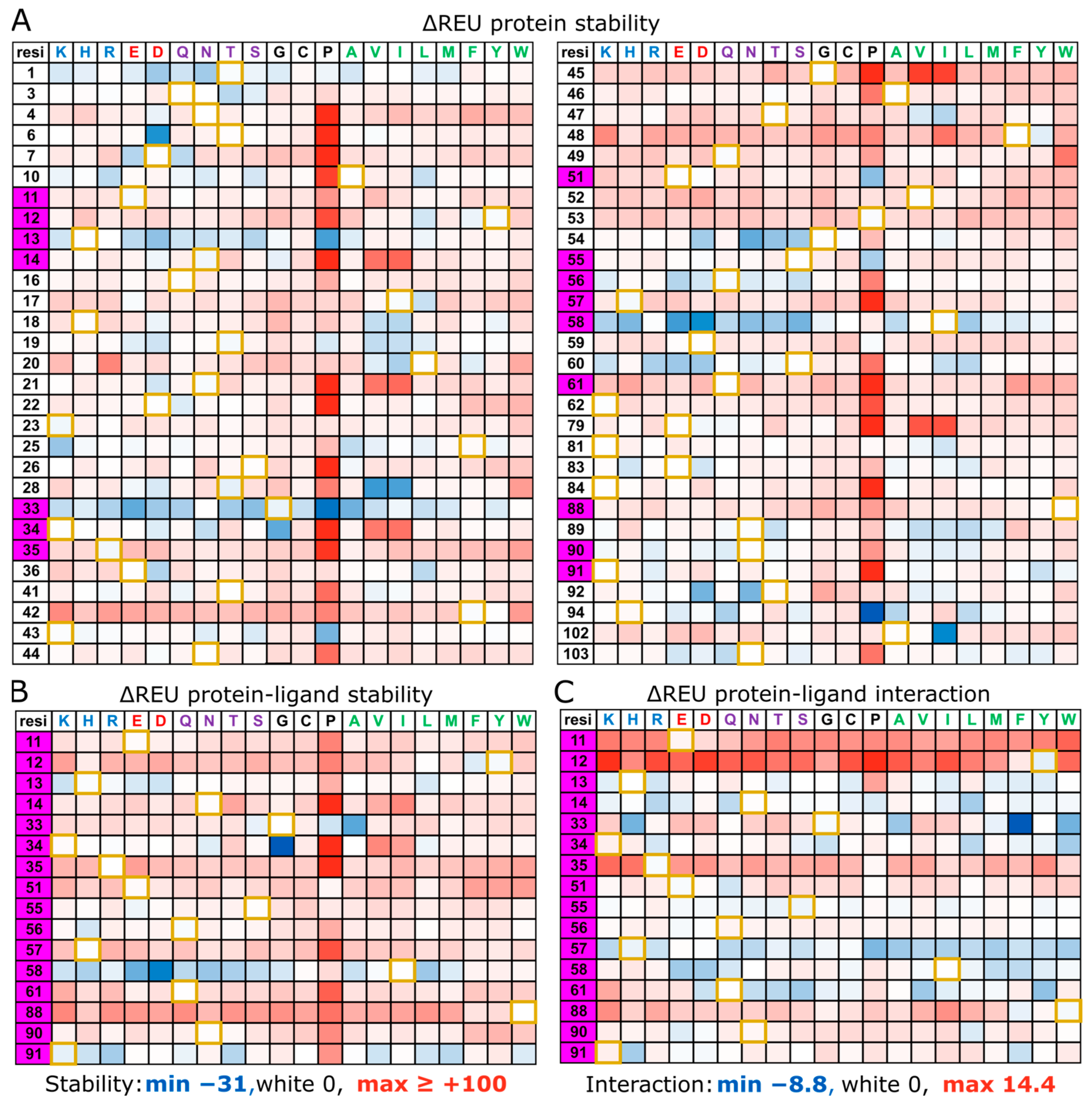

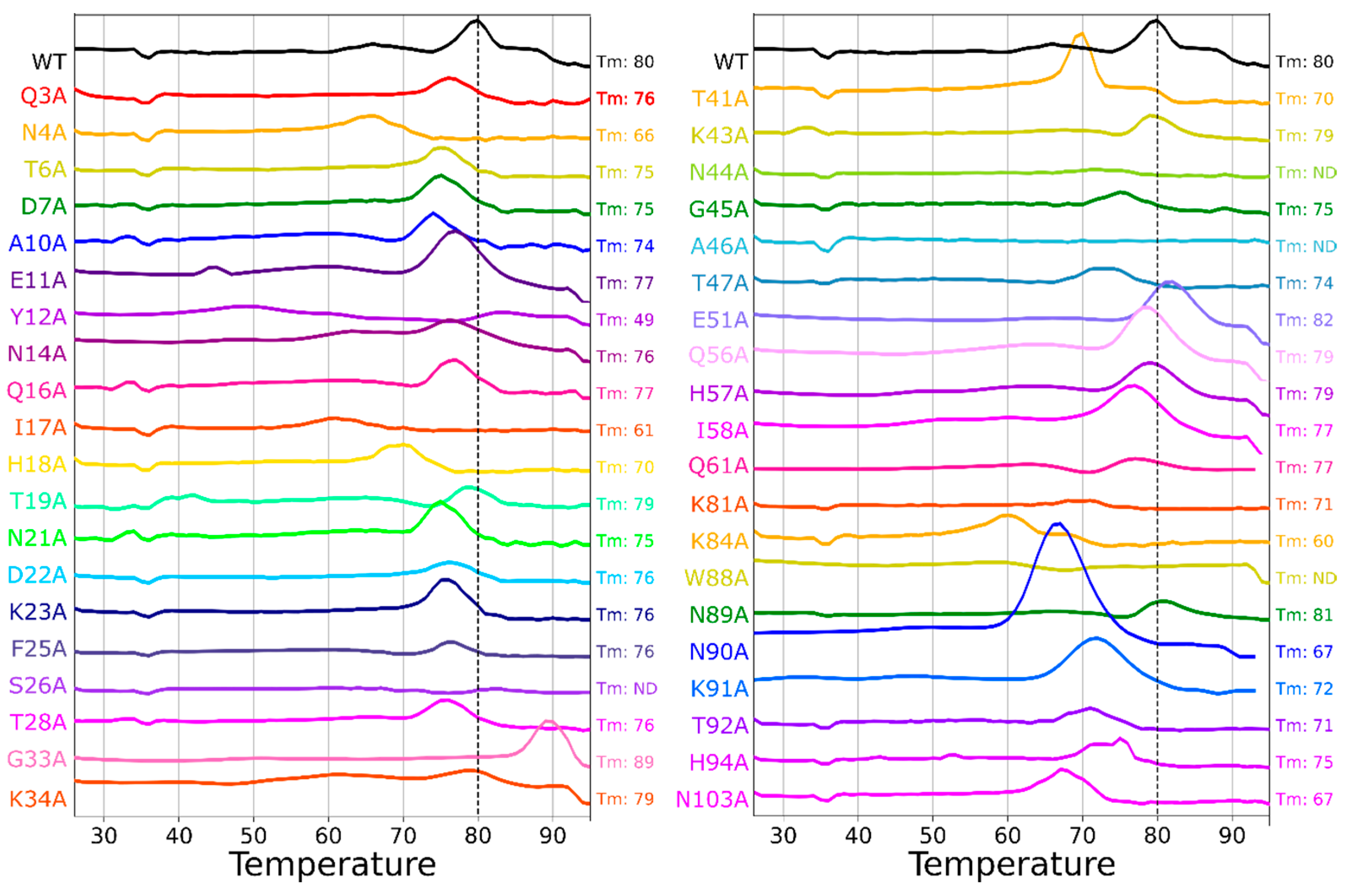
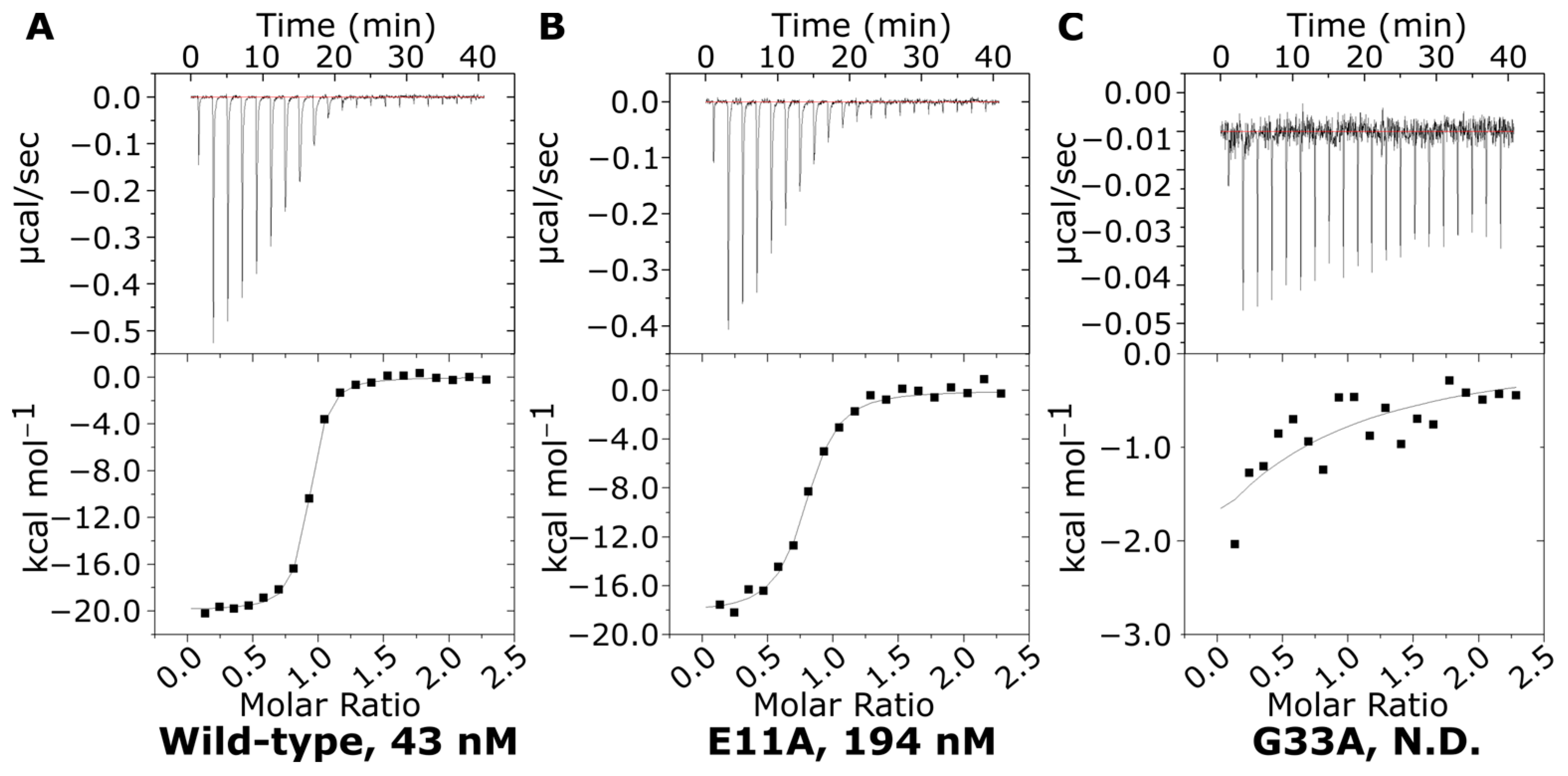
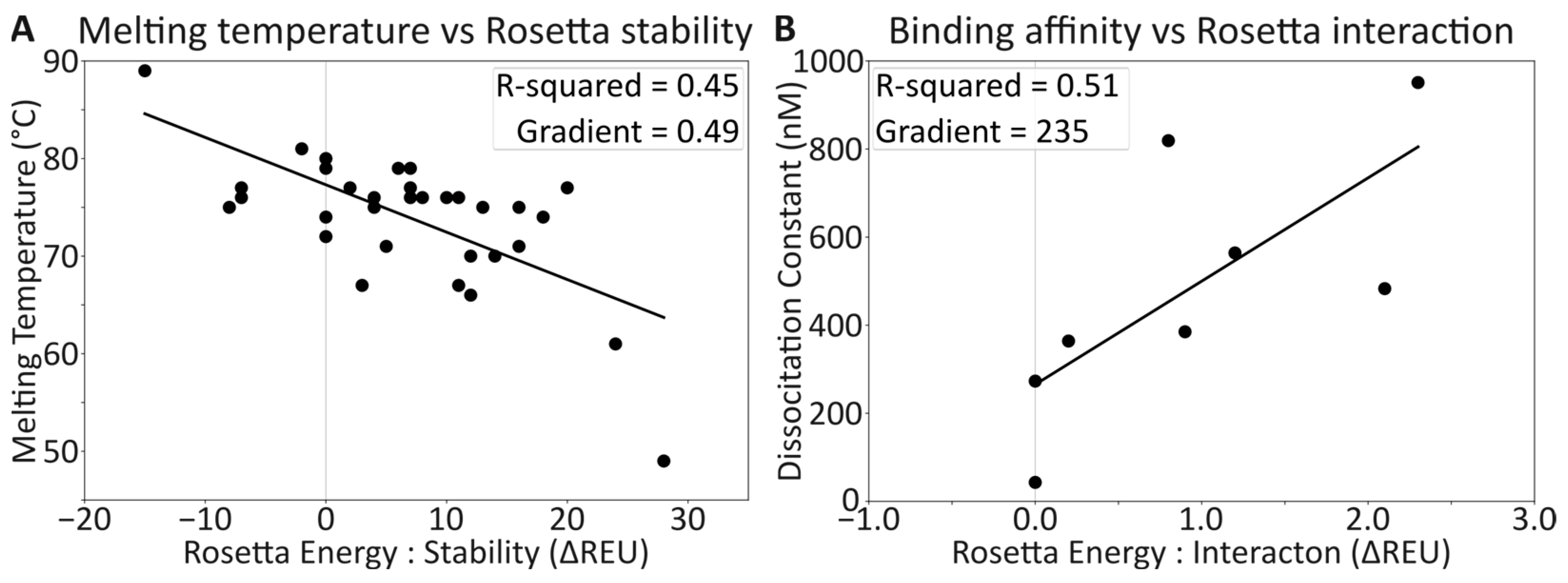
Disclaimer/Publisher’s Note: The statements, opinions and data contained in all publications are solely those of the individual author(s) and contributor(s) and not of MDPI and/or the editor(s). MDPI and/or the editor(s) disclaim responsibility for any injury to people or property resulting from any ideas, methods, instructions or products referred to in the content. |
© 2024 by the authors. Licensee MDPI, Basel, Switzerland. This article is an open access article distributed under the terms and conditions of the Creative Commons Attribution (CC BY) license (https://creativecommons.org/licenses/by/4.0/).
Share and Cite
Au, C.W.; Manfield, I.; Webb, M.E.; Paci, E.; Turnbull, W.B.; Ross, J.F. The Mutagenic Plasticity of the Cholera Toxin B-Subunit Surface Residues: Stability and Affinity. Toxins 2024, 16, 133. https://doi.org/10.3390/toxins16030133
Au CW, Manfield I, Webb ME, Paci E, Turnbull WB, Ross JF. The Mutagenic Plasticity of the Cholera Toxin B-Subunit Surface Residues: Stability and Affinity. Toxins. 2024; 16(3):133. https://doi.org/10.3390/toxins16030133
Chicago/Turabian StyleAu, Cheuk W., Iain Manfield, Michael E. Webb, Emanuele Paci, W. Bruce Turnbull, and James F. Ross. 2024. "The Mutagenic Plasticity of the Cholera Toxin B-Subunit Surface Residues: Stability and Affinity" Toxins 16, no. 3: 133. https://doi.org/10.3390/toxins16030133
APA StyleAu, C. W., Manfield, I., Webb, M. E., Paci, E., Turnbull, W. B., & Ross, J. F. (2024). The Mutagenic Plasticity of the Cholera Toxin B-Subunit Surface Residues: Stability and Affinity. Toxins, 16(3), 133. https://doi.org/10.3390/toxins16030133






